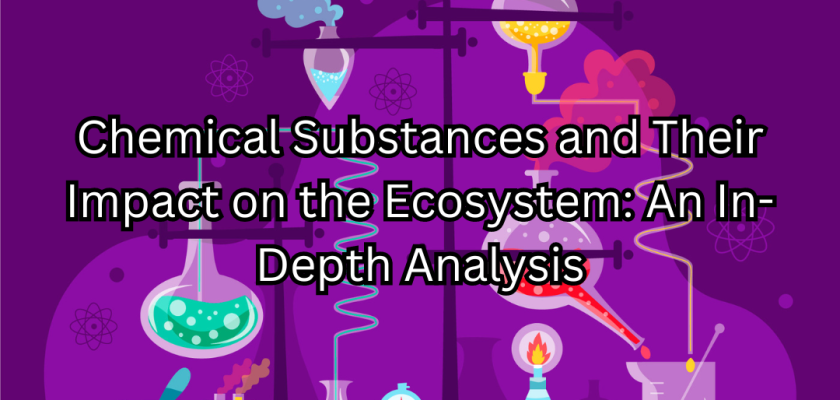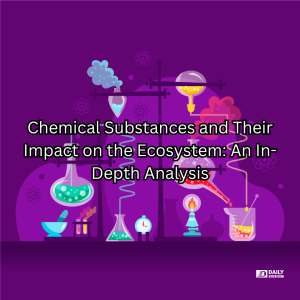Introduction:
Chemical substances, both natural and synthetic, play a crucial role in modern society. They are used in agriculture, industry, medicine, and numerous other fields. However, their widespread use and improper disposal have raised significant environmental concerns. This essay explores the various ways chemical substances impact ecosystems, focusing on pollution, bioaccumulation, and the subsequent effects on biodiversity and human health.
Pollution
One of the most evident impacts of chemical substances on the ecosystem is pollution. Industrial processes, agricultural activities, and urbanization contribute to the release of pollutants into the environment. These pollutants can be broadly categorized into air, water, and soil contaminants.
Air Pollution:
Airborne chemicals, such as sulfur dioxide, nitrogen oxides, and volatile organic compounds (VOCs), originate from industrial emissions, vehicle exhaust, and the burning of fossil fuels. These substances can lead to the formation of smog and acid rain, which have detrimental effects on both terrestrial and aquatic ecosystems. For example, acid rain can lower the pH of water bodies, making them uninhabitable for many aquatic species.
Water Pollution:
Water bodies are often contaminated by agricultural runoff, industrial discharge, and untreated sewage. Pesticides, herbicides, heavy metals, and pharmaceuticals are common pollutants. These chemicals can disrupt aquatic ecosystems by altering water quality, reducing oxygen levels, and harming or killing aquatic organisms. For instance, the presence of nitrates and phosphates from fertilizers can lead to eutrophication, resulting in algal blooms that deplete oxygen and create dead zones.
Soil Pollution:
Soil contamination occurs through the use of pesticides, improper disposal of industrial waste, and leakage from landfills. Chemicals such as heavy metals (e.g., lead, mercury) and persistent organic pollutants (POPs) can accumulate in the soil, affecting its fertility and posing risks to plants, animals, and microorganisms. Contaminated soil can also lead to the uptake of harmful substances by crops, entering the food chain and impacting human health.
Bioaccumulation and Biomagnification
Bioaccumulation refers to the accumulation of chemical substances in an organism over time, while biomagnification illustrates how these substances’ concentration rises as they ascend the food chain.. These processes are particularly concerning for persistent, bioaccumulative, and toxic (PBT) chemicals, such as polychlorinated biphenyls (PCBs), dioxins, and certain pesticides like DDT.
When organisms at the lower trophic levels, such as plankton or small fish, absorb these chemicals, they are not easily metabolized or excreted. As larger predators consume these contaminated organisms, the concentration of the chemicals increases. This can have severe consequences for top predators, including birds of prey, large fish, and mammals, leading to reproductive failures, developmental abnormalities, and increased mortality rates.
For example, the use of DDT in the mid-20th century led to the thinning of eggshells in birds of prey, such as the bald eagle and peregrine falcon, causing significant population declines. Although DDT has been banned in many countries, its persistence in the environment means that its effects are still observed today.
Impact on Biodiversity
Chemical pollutants can have profound impacts on biodiversity, affecting species diversity, abundance, and ecosystem functions. Sensitive species may be directly harmed by toxic chemicals, while others may suffer indirectly through habitat degradation and changes in food availability.
Loss of Species:
Direct exposure to toxic chemicals can lead to the death of individual organisms or entire populations. Waterborne pollutants particularly affect aquatic species., while terrestrial species may be affected by contaminated soil and air. Amphibians, which have permeable skin and rely on both aquatic and terrestrial habitats, are especially at risk.
Habitat Degradation:
Pollutants can alter the physical and chemical properties of habitats, making them unsuitable for certain species. Acid rain, for example, can change soil composition and water chemistry, affecting plant growth and the organisms that depend on them. Similarly, oil spills can smother marine habitats, killing plants and animals and disrupting ecosystem functions.
Food Chain Disruption:
Bioaccumulation and biomagnification can disrupt food chains by affecting key species. The decline or loss of top predators can lead to an overabundance of prey species, which in turn may overexploit their own food resources, causing cascading effects throughout the ecosystem. For example, the decline of large predatory fish due to mercury contamination can lead to an increase in smaller fish and invertebrates, which may then deplete plankton populations and alter nutrient cycling.
Human Health Implications
The impact of chemical substances on the ecosystem also has significant implications for human health. Contaminated water, air, and soil can lead to direct exposure to harmful chemicals, while the accumulation of toxins in the food chain can result in long-term health issues.
Water Contamination:
Polluted water sources can result in a variety of health issues, such as gastrointestinal disorders and more severe conditions like cancer. In drinking water, organic pollutants and heavy metals are especially dangerous because they can build up in the body and have long-term negative effects on health.
Air Quality:
Exposure to air pollutants, such as particulate matter, ozone, and toxic gases, is linked to respiratory and cardiovascular diseases. Vulnerable populations, including children, the elderly, and those with preexisting health conditions, are at greater risk.
Food Safety:
The presence of chemical contaminants in food can pose serious health risks. Bioaccumulated toxins in fish and other seafood, for example, can lead to neurological and developmental disorders in humans, particularly affecting pregnant women and young children.
Mitigation and Regulation
In order to lessen the harm that chemicals cause to ecosystems, stringent regulations and effective management practices are essential. Governments and international bodies have established various frameworks to control the use, release, and disposal of hazardous chemicals.
Regulatory Measures:
Policies such as the European Union’s REACH (Registration, Evaluation, Authorization, and Restriction of Chemicals) and the United States’ Toxic Substances Control Act (TSCA) aim to ensure the safe use of chemicals. These regulations require manufacturers to assess the environmental and health risks of their products and take appropriate measures to mitigate them.
Sustainable Practices:
Promoting sustainable agricultural and industrial practices can reduce the reliance on harmful chemicals. Integrated pest management (IPM), for example, emphasizes the use of biological controls and environmentally friendly pesticides. Similarly, adopting green chemistry principles can lead to the development of safer and more sustainable chemicals and processes.
Public Awareness and Education:
Raising awarenessconcerning How chemicals affect human health and the environment are crucial for encouraging responsible behavior and supporting regulatory efforts. Public education campaigns can inform individuals about the proper disposal of household chemicals, the benefits of organic farming, and the importance of reducing chemical use in everyday life.
Conclusion
Chemical substances have significantly shaped modern society, but their impact on ecosystems cannot be overlooked. Pollution, bioaccumulation, and the resulting effects on biodiversity and human health highlight the need for careful management and regulation of these substances. By adopting sustainable practices, enforcing strict regulations, and raising public awareness, we can mitigate the adverse effects of chemical substances and protect the health of our ecosystems and ourselves.


